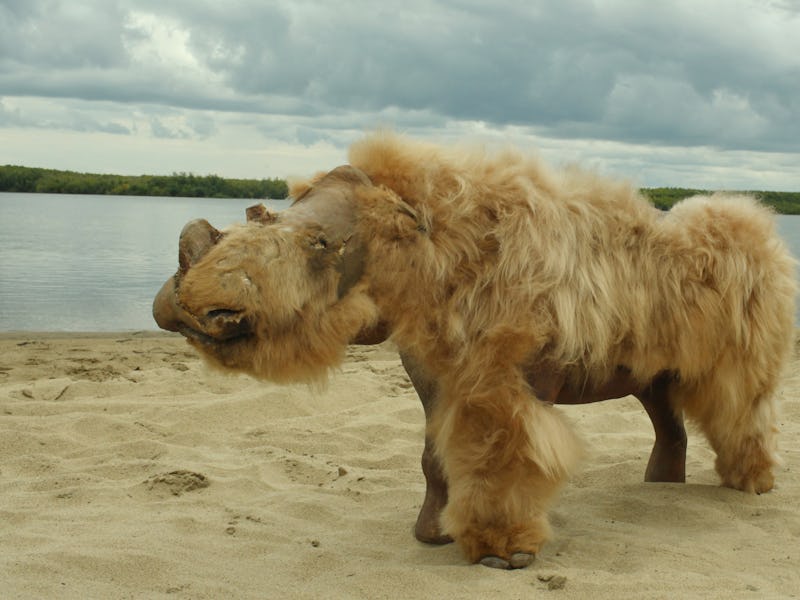Humans off the hook for woolly rhino extinction — study
Things were looking bleak even before early humans began hunting.

The woolly rhinoceros is the less-famous counterpart to fellow mega-herbivore, the woolly mammoth. The prehistoric animals' shared namesake, a thick coat of fur, is a survival trait that came in handy during their Late Pleistocene reign in northern Eurasia.
For the woolly rhino, however, being well-adapted to cold climates was likely part of what triggered the downfall of the species, a new genetic analysis shows.
As the Ice Age ended, early humans began to spread across the globe, and the woolly rhinoceros and mammoth each went extinct. Previously, researchers hypothesized that Homo sapiens over-hunted the megafauna, leading to their demise.
In a study published Thursday in the journal Current Biology, researchers detail how they sequenced DNA from the remains of 14 woolly rhinos, Coelodonta antiquitatis, and determined that climate change — not the spread of humans — is actually what ended the woolly rhino.
Researchers once believed that humans appeared in northern Siberia — where the samples are from — around the same time the woolly rhino went extinct, 14,000 or 15,000 years ago. But recent evidence suggests humans were in the area more than 30,000 years ago. Because their intrusion on rhino territory didn't seem to line up with the animals' demise, this team decided to investigate.
"If anything, we actually see something looking a bit like an increase in population size during this period," senior study author Love Dalén, a professor at the Center for Paleogenetics, explains.
A woolly rhinoceros skeleton.
Dalén's team sequenced rhino hair, bone, and tissue to estimate their population size up to tens of thousands of years before they went extinct. Around the time that humans came on the scene, the population remained constant — and inbreeding was low.
Population trends — Previous research on woolly mammoths indicates what happens to the species when humans hunt dwindling populations: In the case of the mammoth, small numbers gave way to inbreeding and subsequent genetic diseases. With a small population size, woolly mammoths weren't able to breed out health problems.
Early humans hunted woolly rhinos, too. Here's the BBC's take on what a Neanderthal going up against a woolly rhino would have been like:
But despite the new hunters, rhino populations remained stable thousands of years after humans began to inhabit Siberia. The new genetic analyses suggests that a different challenge — rising temperatures — was what was actually overwhelmed the rhinos.
In addition to their woolly coat, rhinos had special skin receptors for sensing temperature, this study shows. Being well-adapted to cold had its downfall as the weather warmed — particularly, researchers believe, during a warming period called the Bølling-Allerød interstadial.
Next, the research team plans to study how climate change affected other megafauna that were adapted to living in the cold.
"We know the climate changed a lot," Dalén said, "but the question is: how much were different animals affected, and what do they have in common?"
Abstract: Ancient DNA has significantly improved our understanding of the evolution and population history of extinct megafauna. However, few studies have used complete ancient genomes to examine species responses to climate change prior to extinction. The woolly rhinoceros (Coelodonta antiquitatis) was a cold-adapted megaherbivore widely distributed across northern Eurasia during the Late Pleistocene and became extinct approximately 14 thousand years before present (ka BP). While humans and climate change have been proposed as potential causes of extinction, knowledge is limited on how the woolly rhinoceros was impacted by human arrival and climatic fluctuations]. Here, we use one complete nuclear genome and 14 mitogenomes to investigate the demographic history of woolly rhinoceros leading up to its extinction. Unlike other northern megafauna, the effective population size of woolly rhinoceros likely increased at 29.7 ka BP and subsequently remained stable until close to the species’ extinction. Analysis of the nuclear genome from a 18.5-ka-old specimen did not indicate any increased inbreeding or reduced genetic diversity, suggesting that the population size remained steady for more than 13 ka following the arrival of humans. The population contraction leading to extinction of the woolly rhinoceros may have thus been sudden and mostly driven by rapid warming in the Bølling-Allerød interstadial. Furthermore, we identify woolly rhinoceros-specific adaptations to arctic climate, similar to those of the woolly mammoth. This study highlights how species respond differently to climatic fluctuations and further illustrates the potential of palaeogenomics to study the evolutionary history of extinct species.
This article was originally published on